 Last Updated February 9, 2025
Last Updated February 9, 2025
The most common Vitamix shopper’s question is some variant of, “I want to make smoothies, soups, and frozen desserts. Which Vitamix blender is best for me?” The answer is that all Vitamix machines work great for those tasks; which one is best depends on the volumes you want to blend and whether you want to pay for extra features.
If you don’t want to go through the nitty-gritty, here are my quick Vitamix recommendations:
Which is the best Vitamix model?
Best Value
- E310 (short/narrow container for small to medium amounts)
- Recon 5200 (tall/narrow container for small to large amounts)
- Recon E320 (short/wide container for medium to large amounts)
Money Is No Object
- Ascent X5 (latest and greatest)
The February 2025 shopping landscape
Most Vitamix models are on sale through Feb 22nd for the President’s Day Sale. Here is the sale.
Vitamix recently released a new set of Ascent models. Full details are in my Vitamix Ascent X Series Review.
The Food Processor Attachment gives more reason to consider Ascent and Venturist models, since it is not compatible with classic models. If you don’t care about the premium finish of the A3500, consider saving big on the Reconditioned Venturist.
If you are looking for the lowest possible price, I recommend choosing between the Recon 5200, the E310, and the Recon E320. The most significant difference between these models is the container they come with, so use the following Venn diagram to pick the optimal container for you. There are trade-offs between the three container options. To put it briefly, “short, narrow, or large capacity: pick 2”: 
Note to visitors from outside the United States: The model availability described on this page is for the USA (and APO/FPO addresses). If you are shopping from Canada, check out my page about Canadian Vitamix models.
For most people, I recommend choosing from the following four categories: Certified Reconditioned models, Explorian, Premium Classic, and Ascent.
Reconditioned
 If you are looking for the lowest possible price on Vitamix, reconditioned is for you. Some people are hesitant to buy reconditioned, and that is a valid concern with some companies, but Vitamix’s reconditioned units are guaranteed to be top quality. The only reasons I would avoid reconditioned Vitamix are if it is for a gift for someone who won’t understand, or if you want some of the features not available on reconditioned machines.
If you are looking for the lowest possible price on Vitamix, reconditioned is for you. Some people are hesitant to buy reconditioned, and that is a valid concern with some companies, but Vitamix’s reconditioned units are guaranteed to be top quality. The only reasons I would avoid reconditioned Vitamix are if it is for a gift for someone who won’t understand, or if you want some of the features not available on reconditioned machines.
Explorian
 If you prefer a slightly smaller container, I highly recommend the new E310, which comes with a short and narrow 48-oz container (full review). The Explorian E320 is functionally identical to the E310, but it comes with a wide container. That makes it nearly identical to the 5300. (The E320 replaces the 5300 in the model lineup, and it is mostly the same, with a few changes: it does not have the on-off switch on the side, and it does not light up when on. I don’t think these differences matter much, but there they are for anyone wondering about E320 vs. 5300.)
If you prefer a slightly smaller container, I highly recommend the new E310, which comes with a short and narrow 48-oz container (full review). The Explorian E320 is functionally identical to the E310, but it comes with a wide container. That makes it nearly identical to the 5300. (The E320 replaces the 5300 in the model lineup, and it is mostly the same, with a few changes: it does not have the on-off switch on the side, and it does not light up when on. I don’t think these differences matter much, but there they are for anyone wondering about E320 vs. 5300.)
There is now also an Explorian E520, which comes with the wide 64-oz container and adds 3 preset blending modes. With the hidden discount that gets activated after clicking a Vitamix link on this site and then adding the Recon E520 to your shopping cart, it is an excellent deal.
Premium Classic and Propel
If you want the most premium machine, but don’t want the new technology of Ascent, then the Professional Series 750 is for you. I think the Ascent machines are quite nice, but you might not like the look of their digital display, or you might want to be able to use older containers (without NFC chips).
In 2023 Vitamix released a new Series, which they are calling the Propel. Similar to the Pro 750, these machines have preset modes and a secondary on-off switch. The Propel machines also have the subtly updated styling that was released with the Explorian series: Propel 510 and Propel 750.
Ascent (Smart System Blenders)
If you want to buy into the future of Vitamix, the Ascent Series is the way to go. It’s priced in the same range as new Legacy models, but it comes with various upgrades (among them: longer warranty, timer display, can use small cups without bulky adapter, and a wireless connection to smartphone app).

 Within the Ascent Series, the A2300 is the lowest-priced model and it has everything you need. (If you’re buying reconditioned, the A2500 is the lowest-priced model, and it has all the features of the A2300, including full variable speed control, and it adds 3 preset program modes.) If you feel like upgrading, I recommend going all the way up to the A3500, because it has premium finish options. (I’m not saying that the intermediate Ascent models are a bad choice, they just wouldn’t be my choice.) See my Ascent review page for more details.
Within the Ascent Series, the A2300 is the lowest-priced model and it has everything you need. (If you’re buying reconditioned, the A2500 is the lowest-priced model, and it has all the features of the A2300, including full variable speed control, and it adds 3 preset program modes.) If you feel like upgrading, I recommend going all the way up to the A3500, because it has premium finish options. (I’m not saying that the intermediate Ascent models are a bad choice, they just wouldn’t be my choice.) See my Ascent review page for more details.
If you’ve been putting off getting a Vitamix because you’re saving up, you can get one right away with a payment plan. If you make on-time payments, there are zero financing fees.
You can leave a comment below or contact me if you are still having trouble deciding which one to get.
Comparison of pre-Ascent models follows
If you want to quickly see the relation between all of the different Vitamix models, you can jump ahead to my comparison chart.
I made an interactive tool to help explore the different features. Try playing with it to get a sense of which you are interested in. You can click any model to go to its Vitamix.com page, or you can read more about the different models below.
+ Show model selection tool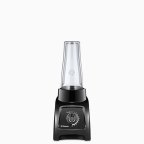 Recon S30
Recon S30  Recon 2-Speed
Recon 2-Speed  Recon 5200
Recon 5200  Recon 5300
Recon 5300  Recon Pro 500
Recon Pro 500 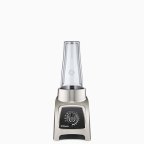 Recon S55
Recon S55  S30
S30  2-Speed
2-Speed 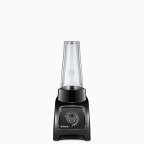 S50
S50  Recon 7500
Recon 7500  5200
5200  S55
S55 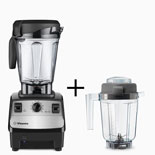 Recon 5300 + 32oz
Recon 5300 + 32oz  Recon Pro 750
Recon Pro 750  7500
7500  Pro 500
Pro 500  Recon 7500 + 32oz
Recon 7500 + 32oz  Pro 750
Pro 750 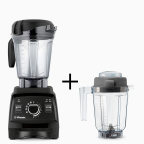 Recon Pro750+32oz
Recon Pro750+32oz  7500 + 32oz
7500 + 32oz  Pro 750 + 32oz
Pro 750 + 32oz  780
780 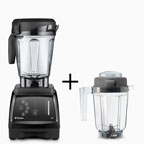 780 + 32oz
780 + 32oz(If you want the 32-oz container, you have to add it to your cart separately: 32-oz container link)
If you’re overwhelmed by the choices and just want to know my preference, I’ve used all of the different types of Vitamix blenders, and before I started using Ascent, the one I used on a daily basis was the 7500, with an extra 32-oz container for blending smaller amounts. (For the best deal, check out certified reconditioned.) All of the models are excellent, and I don’t think there is a wrong choice. (Plus, if you change your mind in the first 30 days, you can get a full refund, including free shipping both ways.)
Summary of Differences
These are the five key decisions to make when deciding which Vitamix to buy:
The following comparison chart shows the relations between the different machines in the S-Series, C-Series, and G-Series. The machines within most boxes of the chart are identical, but they come with different accessories and cookbooks (the exceptions are the S50 and S55, where the S55 has 2 more presets than the S50, and the Pro 750 and Vitamix 780, where the 780 has a flat touchpanel control). Generally the differences in accessories/cookbooks are pretty marginal, so I’d recommend going for the lowest price model within the box.

(“+” indicates there are also more expensive options in addition to the price listed in the chart. The following machines are not shown because they do not fit in with the rest: the Vitamix Turboblend Two Speed and Three Speed lack variable speed control, and the Vitamix 5300 and 6500 are a hybrid of the 6300 and 7500—i.e. they have a 7500 container on a 6300 base, without or with presets.)
Personal Blender? (S-Series vs. C-Series and G-Series)
(Vitamix S30 and S55 vs. 5200, 7500, et al.)
 In 2014 Vitamix released the Vitamix S30. It is smaller than the other Vitamix models, and also comes with a combination blending container/to-go smoothie cup. The Vitamix S50 and Vitamix S55 came out in 2015, and they are the same as the S30 but add preset modes. Since these models are significantly different from all the other models, I put up a detailed Vitamix S30 and S-Series review. If you are considering a smaller blender, or like the idea of blending in a to-go smoothie cup, you should check them out. Not surprisingly, the S-Series’ smaller size means that their maximum capacity is lower the other models (40 oz vs 64 oz).
In 2014 Vitamix released the Vitamix S30. It is smaller than the other Vitamix models, and also comes with a combination blending container/to-go smoothie cup. The Vitamix S50 and Vitamix S55 came out in 2015, and they are the same as the S30 but add preset modes. Since these models are significantly different from all the other models, I put up a detailed Vitamix S30 and S-Series review. If you are considering a smaller blender, or like the idea of blending in a to-go smoothie cup, you should check them out. Not surprisingly, the S-Series’ smaller size means that their maximum capacity is lower the other models (40 oz vs 64 oz).
Variable Speed?
(Vitamix Two Speed vs. 5200 and Vitamix 6000 vs. 6300)
 The variable speed control found on all Vitamix machines except for the Two Speed and 6000 is useful for when you don’t want to fully liquefy your blend. Examples are pesto, salsa, or chopping vegetables. If you don’t have variable speed, you can get away with quickly pulsing, but you won’t have quite as much control. The variable speed also makes the “bubble removal trick” more effective, although pulsing on low speed also works.
The variable speed control found on all Vitamix machines except for the Two Speed and 6000 is useful for when you don’t want to fully liquefy your blend. Examples are pesto, salsa, or chopping vegetables. If you don’t have variable speed, you can get away with quickly pulsing, but you won’t have quite as much control. The variable speed also makes the “bubble removal trick” more effective, although pulsing on low speed also works.
Preset Programs?
(Vitamix Two Speed vs. 6000, Vitamix 5200 vs. 6300, Vitamix Professional Series 200 vs. Professional Series 500, Vitamix S30 vs. S55, and Vitamix Professional Series 300 vs. Professional Series 750)
 The preset programs on the 6000, 6300/Pro 500, S55, and Pro 750 allow you to select a program, turn it on, and then the machine will automatically ramp up the speed and then shut off after a certain amount of time. There are a number of reasons that people appreciate this function:
The preset programs on the 6000, 6300/Pro 500, S55, and Pro 750 allow you to select a program, turn it on, and then the machine will automatically ramp up the speed and then shut off after a certain amount of time. There are a number of reasons that people appreciate this function:
• You can start the machine and “walk away” to do something else.
• If you strictly follow recipes the presets can yield more consistent results.
• Presets can give new users more confidence with the machine.
However, the presets do not work perfectly every time. Sometimes ingredients require tamping to start circulating past the blades, so you can’t always “walk away.” Also, the preset time might not be the optimum blending time if you modify a recipe. You may find that your smoothie is not fully blended after the smoothie program runs, so you have to run it again. A commercial coffee or smoothie shop makes the same recipes over and over, so in that setting presets are extremely useful. If you constantly make new combinations and of differing amounts, as many home users do, the settings may be less useful. It’s not too hard to tell when something is sufficiently blended, and after a few trials anyone should be able to figure it out. For these reasons, I personally would not pay extra for the preset settings. However, I know many people who have the presets love them. One thing to remember is that the machines with presets still have the variable speed knob for full manual control. If you don’t mind the added cost of presets, you can always switch back and forth to manual control.
C-Series vs. G-Series (Next Generation)?
(Vitamix 5200 vs. 7500, and Vitamix Professional Series 500 vs. Professional Series 750)
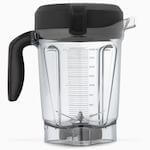 Vitamix released the “Next Generation,” aka “G-Series,” models in 2012. Both the base and the pitcher have an updated design. The base has slightly better sound muffling and also has better airflow which means that it can work harder before it overheats. To go with the better-cooled motor, the updated pitcher has a 4-inch blade instead of the Standard/Classic “C-Series” 3-inch blade. The 4-inch blade is in a shorter and wider container that has the same capacity as the 64-oz C-Series container.
Vitamix released the “Next Generation,” aka “G-Series,” models in 2012. Both the base and the pitcher have an updated design. The base has slightly better sound muffling and also has better airflow which means that it can work harder before it overheats. To go with the better-cooled motor, the updated pitcher has a 4-inch blade instead of the Standard/Classic “C-Series” 3-inch blade. The 4-inch blade is in a shorter and wider container that has the same capacity as the 64-oz C-Series container.
Advantages of the wider design:
• less need for the tamper (ingredients fall into the blades more easily)
• better chopping capability (you can course-chop more ingredients at a time)
• easier to scrape thick mixtures out
Advantage of shorter design:
• easier storage (at 17.5” tall, the container with lid on the base fits under standard kitchen cabinets)
Advantages of the 4-inch blade:
• faster processing time
• under some circumstances, marginally smoother blends
The one disadvantage of the new container is that for small volumes of under ~2 cups it does not work quite as well as the C-Series narrow container. The G-Series wider design causes two things to happen. First, there is more splashing up onto the inside of the lid and upper walls of the container, which means you lose a small amount of your blend unless you carefully scrape off the lid and walls. Second, you need slightly more volume to cover the blades and get good circulation going. The minimum volume to blend depends on what you are blending, and also on how much effort you are willing to spend pushing ingredients back into the blades. For example, for best results, the narrow containers can make nut butter easily by starting with 3 cups of nuts, whereas the wider Next Generation containers do best with 4 cups of nuts. For easier, more liquidy, blends, you can go below 1 cup in either container, but Next Generation containers will splash around more.
This disadvantage is a non-issue if most of your blends are over 2 cups, or if you are willing to spend a bit more to buy an additional narrow container, which will give you the best of both worlds. I like the 32-oz container for this purpose, although the 48-oz container has the same narrow bottom so it works just as well. The 48-oz container is just a bit bulkier on the outside because it sits outside the centering posts instead of inside of them, and its top is wider as well.
(The narrow C-Series Vitamix containers are compatible with G-Series models, but the G-Series containers are not recommended for use on C-Series models. The longer G-Series blades increase the load, and Vitamix does not recommend the C-Series cooling system for those increased loads.)
Reconditioned?
 Buying reconditioned is a great way to save money. For more details on deciding about buying reconditioned, see my refurbished Vitamix page.
Buying reconditioned is a great way to save money. For more details on deciding about buying reconditioned, see my refurbished Vitamix page.
Continue on for more details of each model type…
The array of different Vitamix blenders is a bit confusing, but it turns out that there is a lot of redundancy between the different models. I am only discussing models made for consumer/home use. Their commercial blenders are not ideal for home use because they are generally more expensive and have shorter warranties (3 years vs 7 years for home use; they are warrantied for constant use—think of how many times per day a blender at Jamba Juice runs compared to at your home).
The Vitamix website currently lists over 30 different home models, but they are all variants of three main designs: “personal” (S-Series), “standard/classic” (C-Series), and “next generation” (G-Series). For each of these main designs there are a few different options, to make a total of 8 different machine types. The rest of the models have identical bases, but come with different containers and/or accessories.
S-Series Motors
If the smaller size, dishwasher safe container, and “to-go” blending container appeal to you, please read the full details at my Vitamix S30, S50, and S55 review. For quick reference, the size of the base is 8.3″ deep x 5.9″ wide x 7.7″ tall. With the 20-oz to-go container the total height is 14.55″. The height is 15.66″ with the 40-oz container. These models have lower power, but they are still capable of making all of the usual Vitamix creations, just in smaller quantities.
C-Series Motors (Standard/Classic)
There are three types of bases of the standard variety. The differences are in the controls. The dimensions of the base of these machines are 8.75″ deep x 7.25″ wide x 8.25″ tall. There are three different container size options: 32 oz, 48 oz, and 64 oz, which result in height of base plus container/lid of 16.9″, 17.4″, and 20.5″ respectively.
Standard, no-variable speed (Vitamix TurboBlend Two Speed and Three Speed)
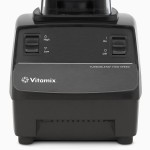 TurboBlend Two Speed (
TurboBlend Two Speed ($399$349); reconditioned for $299. This machine comes with a 5-year warranty and lacks the variable speed knob. Variable speed is useful for cases where you want to have finer control over the texture (i.e. if you don’t want a totally smooth purée). However, you can accomplish some non-liquefying chopping tasks by quickly pulsing the machine. While this is the most affordable new machine, I’d highly recommend looking at the reconditioned 5200, which has the same warranty and adds variable speed for $70 less.
In May 2016 Vitamix came out with a new no-variable speed machine, the TurboBlend Three Speed($499). It is exactly what it sounds like: it has three speed settings: low, medium, and high. It also has a pulse switch, which does the same thing as switching the start-stop button on and off. The pricing on this model is a bit strange, since for $50 less you can get a machine with fully variable speed. Plus, the TurboBlend 3-Speed comes with a 5-year warranty, instead of the 7 years on machines like the 5200.
Standard variable speed (Vitamix 5200 et al.)
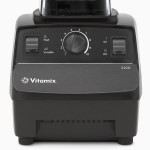 Until recently this was Vitamix’s bread and butter, and they have a lot of models to show for it: 5200 ($449), TurboBlend VS (retired), CIA Pro (retired), Pro 200 ($499), Creations II ($449), and Creations GC (retired); reconditioned for $329. These machines are essentially identical. Some are available with a shorter 48-oz container instead of the 64-oz container. The smaller container is nice because it’s more compact (and fits under standard kitchen cabinets), but of course its capacity is lower. The aesthetics of the switches and dial are slightly different between the different models. The Creations models come with a 5-year warranty, while the rest are 7 years. The 5200 comes with their “whole foods cookbook,” the TurboBlend VS comes with a vegetarian/vegan/raw cookbook and a nutmilk straining bag, the Pro models come with a cookbook with restaurant-oriented recipes (the CIA one—that’s Culinary Institute of America—comes with an additional recipe book). Note that if you buy reconditioned, you cannot choose which of the Standard models you are getting; Vitamix will choose for you based on availability, but remember that functionally they are identical.
Until recently this was Vitamix’s bread and butter, and they have a lot of models to show for it: 5200 ($449), TurboBlend VS (retired), CIA Pro (retired), Pro 200 ($499), Creations II ($449), and Creations GC (retired); reconditioned for $329. These machines are essentially identical. Some are available with a shorter 48-oz container instead of the 64-oz container. The smaller container is nice because it’s more compact (and fits under standard kitchen cabinets), but of course its capacity is lower. The aesthetics of the switches and dial are slightly different between the different models. The Creations models come with a 5-year warranty, while the rest are 7 years. The 5200 comes with their “whole foods cookbook,” the TurboBlend VS comes with a vegetarian/vegan/raw cookbook and a nutmilk straining bag, the Pro models come with a cookbook with restaurant-oriented recipes (the CIA one—that’s Culinary Institute of America—comes with an additional recipe book). Note that if you buy reconditioned, you cannot choose which of the Standard models you are getting; Vitamix will choose for you based on availability, but remember that functionally they are identical.
Sometimes these models are listed with their color-specific SKU. All of the following models are identical to the 5200, they just come with different colors and names: Vitamix 1709, 1363, 1364, 1365, 1709, 1723, 1732. They also sometimes go by VM0103. Vitamix 1978 is also the same, but comes with a 48-oz container.
Standard variable speed + presets (Vitamix 6300 and Professional Series 500)
 Pro 500 ($559) and 6300 (retired); reconditioned for $379. These are the same model; the only difference is that the 6300 comes with the “Savor” cookbook, which has a broader range of recipes than the Pro 500’s “Create” cookbook, which focuses more on restaurant-style recipes that tend to be richer.) They have 3 preset programs that run the blender for a certain amount of time and speed for smoothies, frozen desserts, and hot soups. Their switches are slightly different from the non-preset models. The non-preset models have an on-off switch, a variable speed knob, and a high-variable speed switch. The preset ones have moved the highest speed setting onto the knob and replaced the high-variable speed switch with a pulse switch. This is really a minor aesthetic difference, since you can achieve pulsing on the non-preset models by quickly flicking the on-off switch on and off.
Pro 500 ($559) and 6300 (retired); reconditioned for $379. These are the same model; the only difference is that the 6300 comes with the “Savor” cookbook, which has a broader range of recipes than the Pro 500’s “Create” cookbook, which focuses more on restaurant-style recipes that tend to be richer.) They have 3 preset programs that run the blender for a certain amount of time and speed for smoothies, frozen desserts, and hot soups. Their switches are slightly different from the non-preset models. The non-preset models have an on-off switch, a variable speed knob, and a high-variable speed switch. The preset ones have moved the highest speed setting onto the knob and replaced the high-variable speed switch with a pulse switch. This is really a minor aesthetic difference, since you can achieve pulsing on the non-preset models by quickly flicking the on-off switch on and off.
Some people love the presets because you can set it and walk away (assuming the mixture is circulating and you don’t need the tamper), and because they get more consistent results. However, the more consistent results will only hold if you always add the same quantities and types of items to the blender. For example, if you’re making a small smoothie, you can blend it for less time than if you were making a large one. One other thing is that you can set the non-preset machines and walk away—you just have to come back to stop them. I often use the blending time to rinse off the knife and cutting board that I used. You’re not likely to forget that the Vitamix is running because it’s loud enough to hear throughout the house. The variable speed knob goes to the same high speed as the previous models on high, but it’s lowest setting is a bit faster than on the 5200 et al., so you lose a tiny bit of fine control. Whether the presets are worth it is a personal question—I wouldn’t pay extra for them, but some people love them.
Standard no variable speed + presets (Vitamix 6000)
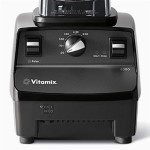 6000 (retired). Released October 2013, this is more of a mash-up of existing machines than a truly new one. It’s a sort of blend between the Two Speed, and the 6300. It does not have variable speed control, but it has six preset timed blending settings. These settings will automatically ramp up the speed, and then turn it off after a specified time of 20 sec, 30 sec, 1 min, 1.5 min, 4.5 min, or 6.5 min. Like the 6300, the pulse control is spring-loaded so that it only stays on as long as you hold it down, and it blends at a medium-low speed.
6000 (retired). Released October 2013, this is more of a mash-up of existing machines than a truly new one. It’s a sort of blend between the Two Speed, and the 6300. It does not have variable speed control, but it has six preset timed blending settings. These settings will automatically ramp up the speed, and then turn it off after a specified time of 20 sec, 30 sec, 1 min, 1.5 min, 4.5 min, or 6.5 min. Like the 6300, the pulse control is spring-loaded so that it only stays on as long as you hold it down, and it blends at a medium-low speed.
G-Series Motors (Next Generation)
In 2012 Vitamix released a new generation G-Series base with improved airflow that makes it run cooler and quieter than the classic C-Series one. With the improved cooling, the G-Series base can use a new pitcher design that is wider and has longer blades. This design makes the tamper less necessary, and makes it easier to get thick mixtures out. The longer blades also process food faster and work better for chopping. The G-Series machines are compatible with the C-Series containers, so if you want to use the dry blade you can use the same classic dry container. Dimensions are 9.4″ deep x 7.7″ wide x 17.5″ tall (with new-style 64-oz container in place). For more details of sizes, check out the PDF footprints I made for my Vitamix S30 review.
Next generation motor (Vitamix 7500, Professional Series 300, and Creations Elite)
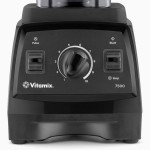 7500 ($529), Creations Elite ($557.50), and Pro 300 ($559); reconditioned for $439. These are all the same machine, so don’t worry about the note on the Reconditioned Next Gen page that says that the label may reflect any of these models. The only difference is the name printed on it. One point of confusion is that the Creations Elite is sold new with a smaller container, but if you happen to get sent a Creations Elite as a Reconditioned Next Gen, it will come with the same low profile 64-oz container that the 7500 comes with.
7500 ($529), Creations Elite ($557.50), and Pro 300 ($559); reconditioned for $439. These are all the same machine, so don’t worry about the note on the Reconditioned Next Gen page that says that the label may reflect any of these models. The only difference is the name printed on it. One point of confusion is that the Creations Elite is sold new with a smaller container, but if you happen to get sent a Creations Elite as a Reconditioned Next Gen, it will come with the same low profile 64-oz container that the 7500 comes with.
Next generation motor + presets (Vitamix Professional Series 750 and Vitamix 780)
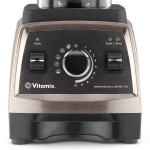
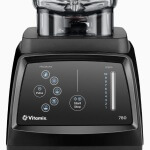 Pro 750 ($599–$649), 780 ($719); available reconditioned: 750 for
Pro 750 ($599–$649), 780 ($719); available reconditioned: 750 for $519–$569$499, and 780 for $519$399. These models have 5 presets: smoothies, frozen desserts, purées, hot soups, and self-washing. If you want to see more details of exactly what the presets do, check out my page about demystifying Vitamix presets. The 780 is identical, except that it has a touchpanel control interface. See my Vitamix 780 review for more details.
Vitamix Heritage 750 vs. Original 750?
In late 2015, Vitamix released a new version of the Pro 750: the Heritage line. The Vitamix Heritage 750 is functionally equivalent to the original Pro 750, but it has two differences on the exterior of the base. The upper shell (see diagram below) is now metal on the Heritage models. The Vitamix website doesn’t put Heritage in the model title, but it’s there in the description.
 The original 750 came in a brushed stainless finish option, but the upper shell was plastic with a thin metallic coat that could be scratched or scuffed. (When I tested the original 750 for a couple of months, I did not see any problems, but I have heard that some people have noticed scratches/scuffs.) The solid metal of the new Heritage models is more durable. Also, the metal shell muffles the the motor a bit more than the plastic, making the Heritage models a bit quieter.
The original 750 came in a brushed stainless finish option, but the upper shell was plastic with a thin metallic coat that could be scratched or scuffed. (When I tested the original 750 for a couple of months, I did not see any problems, but I have heard that some people have noticed scratches/scuffs.) The solid metal of the new Heritage models is more durable. Also, the metal shell muffles the the motor a bit more than the plastic, making the Heritage models a bit quieter.
 The other minor difference is that the Heritage models’ front panel has fewer backlights: Heritage models light up the indicators above the pulse and start-stop switches, whereas the original Pro 750 has backlights around the central knob as well.
The other minor difference is that the Heritage models’ front panel has fewer backlights: Heritage models light up the indicators above the pulse and start-stop switches, whereas the original Pro 750 has backlights around the central knob as well.
The Heritage metal is available in brushed stainless and copper finishes. (Currently on Vitamix.com, the Heritage options are listed on the main Pro 750 page, and the old brushed stainless finish is discontinued.)
I believe it is called Heritage because it is a throwback to the original Vitamix models that had all-metal bases. The plastic that Vitamix has been using for their bases for the past 25 years is extremely durable, so this change won’t affect functional longevity. That said, the elegant finish of the Heritage models will now likely stay unblemished for longer. It’s also nice that Vitamix did not increase the price for this upgrade.
The Vitamix 5300 and 6500
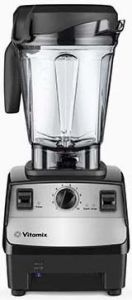 5300 ($529) and 6500 ($599); reconditioned for $360. Vitamix does not currently sell the new models online, only the reconditioned one. These are “new” models for 2015, although they are actually just slightly unexpected mash-ups of previous models. They are a hybrid between a 6300 and a 7500. They use the wide Next Gen (G-Series) container but they have a Classic (C-Series) base. The 5300 has variable speed and a pulse control switch, and has no presets. Meanwhile, the 6500 has the same three presets as the 6300. (Further evidence of equivalence between the 5300/6500 and C-Series models is on the Reconditioned C-Series 6300/Pro 500 page: it says its base may be a 6500.)
5300 ($529) and 6500 ($599); reconditioned for $360. Vitamix does not currently sell the new models online, only the reconditioned one. These are “new” models for 2015, although they are actually just slightly unexpected mash-ups of previous models. They are a hybrid between a 6300 and a 7500. They use the wide Next Gen (G-Series) container but they have a Classic (C-Series) base. The 5300 has variable speed and a pulse control switch, and has no presets. Meanwhile, the 6500 has the same three presets as the 6300. (Further evidence of equivalence between the 5300/6500 and C-Series models is on the Reconditioned C-Series 6300/Pro 500 page: it says its base may be a 6500.)
The reconditioned 5300 is the most affordable option for a machine with the short/wide container.
The strange thing about these models is that previously Vitamix stated that Next Gen containers should not be used on Classic bases because they do not have the updated airflow design that cools the motor more effectively.
I strongly suspect that the 5300 has the same microprocessor speed control as the 7500, Pro 750, and 6300, just without the presets. (You can read about the speed control of the different machines on my Vitamix RPM measurement page.) The microprocessor speed control should help protect the motor when using the wide container at high loads and very low speeds, but at maximum speed it shouldn’t make a difference. The marketing copy for the 5300 says that it comes “with a faster, yet quieter, motor,” but I am skeptical of those claims [Update: interestingly, Vitamix removed that phrase].
The 5300 and 6500 are a bit louder than the G-Series bases, which have sound-dampening technology not present in the C-Series bases. At the same price point, I would prefer the 7500.
Satisfaction Guarantee
Vitamix has a 30-day satisfaction guarantee, so if you have second thoughts you can return a machine within the first 30 days for a full refund and they even pay return shipping.
Warranty
If your machine has any problems during the warranty period of 5 or 7 years, Vitamix will repair or replace it, and they cover shipping costs both ways. For more details about warranties, check out my Vitamix Warranty page.
Reconditioned Vitamix
 I know I already mentioned reconditioned machines, but I want to restate what a great deal I think they are. These factory-refurbished machines offer the best prices you’ll find on Vitamix: 5200 for $329, Pro 500 for $379, and 7500 for $439. For more details, see my refurbished Vitamix page.
I know I already mentioned reconditioned machines, but I want to restate what a great deal I think they are. These factory-refurbished machines offer the best prices you’ll find on Vitamix: 5200 for $329, Pro 500 for $379, and 7500 for $439. For more details, see my refurbished Vitamix page.
Payment Plans
Want to start blending right away, but don’t want to pay the full price up front? Vitamix offers payment plans with zero interest and no fees if you make payments on time. For more information, check out my payment plan page.
Free Shipping
Clicking on any Vitamix link on this page will automatically apply a promotion code, which gives you free shipping on your order of a Vitamix machine (or anything else on Vitamix.com over $50) in the U.S. or Canada. For more details, see my page about the Vitamix promotion code.
Extra Bonus
If you order via a link on this site, Joy of Blending can get a commission. I deeply appreciate your support, and, to thank you, I want to help you get the most out of your new machine. I try to answer all questions from everyone, but sometimes I get swamped. If you order through one of my links, I will give you a private way to contact me so that I can answer your questions before visitors who are not on the special list. Please make sure my link is the last link you click before placing your Vitamix.com order. Then just forward your order confirmation to thanks@joyofblending.com.
Recommended Accessory
I highly recommend a spatula for getting the last bits of thick mixtures out of the container. For the narrow containers I recommend a long narrow spatula. For the wide containers, I recommend Vitamix’s under-blade scraper.
Dry Container
If you’re wondering if you should get a dry container, this new post is for you: Is the dry container worth it?
Phew… so that completes the Vitamix model round-up. I’m looking forward to getting back to describing some actual recipes!
Or follow along on Twitter or Facebook:

Adam, I think I read 90% of your post looking for the answer to my question. I’ m wanting to do smoothies and juicing. I know vitamix is great for smoothies, however, I didn’t see much mentioned about juicing. Should I buy a separate juicer or would the one machine do both? Thanks so much
There was some discussion of this further up in the comments (text search for “juicing” or look for the replies to Sable on April 6/7). A Vitamix can easily make “total juices” that retain the fiber of the produce, and you can thin the total juice out with liquid or juicy produce like grapes. If you want to make a traditional juice with no fiber, you can use a Vitamix, but it will require a second step of straining (with cheese cloth or a nutmilk bag). People who want to regularly drink fiber-removed juices often like to use a juicer, but I personally like to retain all of the fiber so I just use a Vitamix.
Does anyone have a feel for how often the recertified blenders go in and out of stock? I’d like to grab a recertified 7500 right now but they only have the red in stock and my wife says that’s a no-go. Will I be waiting forever for a black one?
I don’t think anyone knows. This was the first time that they sold the next generation models reconditioned. My guess is that it will be some months, and even then it’s not certain .
As of this morning the black reconditioned 7500 is back in stock.
Guess I will not be waiting forever. Thanks for the update!
Confirmed, the Next Gen models are back in stock… just ordered one (with the promo code from this article). I’ve been using a Nutri-Bullet for months, and it works fine, but is just too darn small.
I have the NutriBullet too and I LOVE it. However, I eat a lot, and sometimes I have to make my smoothie in several steps to get the volume I want. So I have decided to get the refurbished Vitamix 7500, but they are out of stock right now 🙁 grrrr… not sure how much patience I will have to wait, or to get a new one. Do you still use your NutriBullet for something on the side of your Vitamix?
As of today the reconditioned 7500 is back in stock in blue and in white.
Yes, Adam, I noticed early this morning. Went to look at the vitamix website and saw it, so I quickly snatched a blue one 🙂 now I can’t wait for it to arrive and start experimenting.
Congrats! They’ve gone back out of stock again!
I inherited a Vitamix from my sister. She bought the machine in 2003 or 2004. I moved years ago and have not been able to find the base for the life of me. I still have the 2 containers, but no base. Have the bases changed over the years or will I still be able to use my older containers with a newer base? Can you tell me what bases should work with a machine purchased in this time frame so I can purchase one?
Those containers are compatible with any new model base.
Thanks, Adam. That’s great news!
Adam you are amazing! I spent a lot of time this afternoon reading all the questions and your very helpful answers/comments/suggestions. This week I had planned on going to Costco to purchase a Vitamix! Ha! Whoa! Now that I am better educated thanks to you, I plan to slow down my purchasing process and think this through. I may even order the red reconstructed 7500. I have a friend who has red appliances in her kitchen and they look marvelous in both her house in Phoenix and her condo on Maui. I will let you know what I decide and how I am doing with it after it arrives. I am total newbee with blenders but excited to get back into the kitchen! Until I retired my husband did most of the cooking!
thank you for such helpful information.
i am interested in a blender for making coconut milk from fresh coconut. i have a tree in the backyard. which blender would you recommend for this. i think it needs to be more powerful than one for making smoothies.
I’m jealous of your coconut tree! Any of the machines on this page (or really any powerful blender) should work for coconut milk. If you want a really smooth coconut milk you’ll want to strain it through something like a nutmilk bag.
I am able to get a reduced price/ free Vitamix through my company’s Wellness program. Employees get points for working out, having annual checkups, not smoking, healthy weight, etc. The points can be traded in for products. There are several Vitamixs avaliable. One is listed as “Vitamix (PSA) Professional Series 300 Blender” Any idea what the PSA stands for? Several of the other models list “64 oz” rather than “PSA”. There is a “Vitamix 64 oz Professional Series 300 Blender” listed but it requires more points/ cost more. I’ve googled Vitamix PSA and gone to the Vitamix websight but I don’t get any clarrification and was hoping you might be able to help me uravel what “PSA” is.
I’ve never heard of PSA Vitamixes. My guess would be that there’s no difference and that “PSA” is an indication that that model was designated to a program like yours rather than retail. The fact that they require fewer points sounds weird, and my guess would be that it was some sort of mistake. If you’re really concerned your best bet would be to call Vitamix (prepare to wait on hold for a while though).
Thanks so much for your suggestion to call Vitamix, Adam. As you said I was on hold for around 25 minutes give or take. But in the end the manufacturer confirmed that PSA simply stands for Professional Series. I was able to purchase a 300 Pro model for $100.69 shipped (along with 3 years of working out, having annual physicals and enduring physical and testing and blood work to prove I am staying in shape). I’m so phsyced! Wouldn’t have been able to figure out which model to get without this post. I so appreciate it that you take the time to keep it update, too.
The smell coming from the motor under heavy use and especially when new is coming from the magnet wire insulation used on the stator and/or rotor parts of the motor. The insulation is typically a varnish and the heat generated under use is baking the varnish more. When you smell it then you will very slightly decrease the life of the appliance. If you really bog it down so there is smoke coming out from the vents then shut the appliance off before you burn it up and/or severely reduce the life. Again, the slight periodic smell from the motor is normal and of minor concern. How do I know? I spent 5 years working with Underwriters Laboratories when doing safety evaluation of motors with a major international power tool company.
Any word on if Vitamix will have any Mother’s Day specials this year?
We can’t be absolutely certain, but I do not think they will. I think the best option for discounted pricing is a reconditioned unit.
We are moving to China for 2 years. Thinking of buying the 7500, my question is the vitamix compatible with 240v 50hz, will this have any impact on warranty? I can use step down transformer for 120v. Thank You in advance.
Vitamix does make 240 V machines, but as far as I know they have not started making next generation ones yet. The 120 V machines sold in the US, including the 7500, are not compatible with 240 V. I think you could use a transformer, but you would have to be very careful to ensure that it could handle the high loads of Vitamix blenders. My understanding is that using a transformer would void the warranty because the transformers do not always work as advertised, and that is out of Vitamix’s control.
Allo from Montreal !
All this is really helpful but now that ive made a choice, I find it difficult to know where to buy it from Canada and not getting to pay crazy amount of fees and shipment 🙁
Can you help me on that ?
Merci
Sorry, I do not know what the best Canadian deals are. All I know is that my free shipping code (06-0070201) will still work for direct Vitamix purchases for you guys.
Adam: I’m a little confused by the pricing structure for VM’s reconditioned program. E.g. They are asking less for reconditioned 6300s / Pro 500 ($379) than for reconditioned 7500s / CElite / Pro 300 ($399). Yet the 6300s/ Pro 500s have a higher retail price.
Any ideas why?
BTW a great website. Very helpful. Thank you.
Yup, one of the mysteries of Vitamix. My only explanation is that it’s related to their targeting of different machines to different markets (which is also related to how they have different model names for identical machines).
hello – my daughter sent me this link and I love it…so much valuable information…now to make a choice! I have just a few questions. I found the code for free shipping but I am unable to find the promotion code – would you be able to provide this code? I need help deciding which of the following: Vitamix 5200 Deluxe Complete Kitchen(comes with 3 containers,cookbooks, start up dvd,set of spatulas and cutting boards not bad for the price) the 6300 or the 7500. Also unsure of purchasing recondition models 6300 and 7500. I was on the Vitamix web site. Again thank you for all of the time that you have dedicated to this link !!!
The promotion code is the same thing as the free shipping code.
As far as choosing a machine, which one is best for you depends on how much you’re willing to spend, what types of things you’re planning on making, and which features are appealing to you….
Thank you for this post! I was on hold with Vitamix for over 15 minutes the other day and when someone finally got to my call, I asked my question and they put me on hold again! I finally hung up, very frustrated. You just answered all of my questions – thanks again!
Please advise which model would be the least heavy & easiest to lift, as I have some strength and grip issues with my hands. Thanks much.
There are two weights to consider: the pitcher weight and the base weight. Most people leave their Vitamix on their counter so they do not lift the base regularly. The difference in weight between Vitamix models is minimal (the standard models are 11 lbs and the next generation models are 12 lbs). If you’re concerned about grip issues, I would recommend one of the smaller containers: either the 48-oz or the 32-oz. The 32-oz container is only available as an accessory, while you can purchase a machine with the 48-oz container—they call it the “Compact Container.”
If you are concerned about the weight of the base, I would recommend looking at the Blendtec machines, which are lighter than Vitamix blenders. (7 lbs vs. 11 or 12lbs)
I wonder if you would care to comment on this video comparison of blenders (including the 5200). My wife recently bought an Oster that worked great for smoothies at first. Now it takes minutes, including stopping to manually stir the contents or un-jam them. I don’t want to spend the money for a 7500 if it will have the same problem.
http://www.youtube.com/watch?v=FkcgBwbE7nw
I’ve seen that video, and I can’t stand it. I do not understand how it ranks so highly in YouTube searches. I don’t think blending a whole unpeeled orange with a tiny bit of liquid is a reasonable test.
That said, the wide style of the 7500 will make manual intervention less necessary. And if things do get stuck, you don’t have to stop the machine and open it up; the included tamper is designed to reach to just above the blades without hitting them (it has a stop that hits the lid to keep it from going into the blades). Also, in the unlikely event that you’re unsatisfied, Vitamix has a money-back guarantee with a 30-day trial period that even covers return shipping.
Fair enough. Do you know how well do they handle frozen fruits? My wife freezes fruits (usually strawberries and banana pieces) that are too ripe for her fresh and uses them in smoothies. Her current blender now takes almost 10 minutes to blend them and requires a lot of stopping and manual stirring, hence the search for a new blender.
Vitamix blenders will handle frozen fruits with ease. Frozen fruit will be totally blended in 30-60 seconds.
One thing to look out for is that if you use all frozen fruits you’ll get more of a sorbet than a smoothie, and you would need to use the tamper to circulate it. But as long as you have something non-frozen (likely some liquid), you’ll get a nice smoothie.
I just sold my Kitchenaid on Craigslist. All the smoothies had lumps of ice and frozen fruit pieces and all the seeds collected at the bottom. Not appealing. I got a 6300 this past weekend. It’s a whole different machine. Smooooth smoothies, frozen adult beverages without ice lumps, the guacamole was wonderful and fast. But the very best thing is the easy cleanup. It makes all the difference in bothering to use it or not. The presets are great, always busy, I know I would forget to shut it off and turn smoothies into hot fruit soup. How the Kitchenaid rated so highly here is a puzzle.
i have the same one and i am loving it as well. the 6300 is a real nice workhorse (blender actually). i went to the nutiva site and got their hemp shakes, chia seeds, and coconut manna (i am retired i do not work for them in any capacity) and it is really doing wonders with my vitamix diet.
How does the old style 2 speed models, (model 2200), compare with those of today.
Aside from the obvious factor of it being nice to see what you’re blending, I’ve never used one of those old models so I can’t say for sure. The biggest thing I would be concerned about with the old models is their rubber gaskets wearing out, and it being hard (or impossible) to find replacements.
I just received my reconditioned 7500 and used it for the first time. What a difference! Previously we were using a popular high end blender (C) and it was alright, it left our smoothies with bits of greens and seeds to chew. Our first taste of a smoothie from the Vitamix 7500 was amazing! The texture was completely smooth with no little bits of seeds or anything else. We were not sure of spending that much money initially but after using it we are wishing we had purchased a Vitamix blender sooner! We are confident of using this blender for a long time, with its obvious quality and heavy duty construction. If anyone is still undecided about purchasing one of these machines, please take my advice and wait no longer!
Hello,
I live in Costa Rica, and do a lot of cooking here. I am coming up to the States next month, and plan to bring home a Vitamix. I would like to save the money by purchasing a reconditioned model, and am looking for your advice on which model will be best in my situation.
First, we have lot’s of brown outs (electricity) here, which can easily damage electronics if you forget to unplug them when not using. So, I imagine that the less “bells and whistles” the better, so the less electronic/computerized it is the better .
Other then daliy smoothies using fresh and frozen fruit, my main use will be for grinding coconut to make coconut milk. This will of course only be the white flesh, but I have burned out the cheap blenders doing it already.
Will the most economical model be just as good as the rest for this?
I really can’t see myself using any presets, so I imagine the most basic will best, but thought I’d run this by you first.
So, no bells and whistles and can grind coconut “meat”
Thanks very much, your articles are great!
I agree with your assessment: the Standard/5200 sounds like the right choice for you. It will handle the coconut meat, and it does not have an electronic microprocessor controller.
I have the 6300 and was wondering if the new shorter container for the 7500 would fit my blender? I would love to be able to get it all under the cabinets on the counter! Thanks for your time. Loved your help w model differences.
Vitamix does not recommend using the next gen container on the standard machines because the longer blades require higher torque. Possibly for this reason, they do not sell the next gen container separately. However, the 48-oz container would work on your machine, and it’s about the same height as the next gen container.
We also wanted to thank you for the very useful, detailed posts and comparisons. In fact, we used your free shipping code, thank you! The story was, we were misinformed and told that the only place to buy the 6300 was on the roadshow; for some reason we were also under the impression that it came with the low profile container. So we ran to Costco on the first day of the roadshow and stood by the demo table for about two hours… They were selling the 6300 and the 5200 (ok, they were pushing the 6300 and really hemming and hawing about the 5200). They made it seem like it was the newest model out, too. We finally bought the 6300 despite the fact that the presets turned us off; it seemed like it could be the first feature to go. We also bought the dry blend container. When we got home, instead of unpacking it, we actually called up Vitamix and found out about the refurbished 7500, with the short container, which apparently doesn’t quite fit the older models; and in Red!! We kept the dry container and took the whole unopened 6300 back to Costco. Today we got our beautiful new (to us), refurbished, Red!, 7500 and we think we made the right choice. We unboxed it while taking pictures every step of the way (which we will post on our blog in a couple of days, nothingbutgoodstuff.wordpress.com). Both containers fit beautifully and honestly, it looks and feels like a brand new machine. There are no external indications that this is not a new machine. It came with the shrink-wrapped books in a nice white box; a feature we hadn’t noticed before is that it has a nice long electrical cord, which in our old, outless-challenged kitchen is a blessing. It actually wraps very neatly on the bottom, away from sight, and it there’s ample room to wrap the entire cord there. We weren’t so much into storing it under cupboards so much as in the cupboard, which has fairly low shelves, and it all fits great (separating the base from the containers). We also thought the switches felt a little loose, though we’ve never used a Vitamix before so we can’t compare. We figured, if it ends up being a problem the manufacturer will resolve it one way or another. It’s beautiful and it will get its first spin first thing tomorrow morning. We couldn’t be more thrilled. We got a great machine at a great price, made in the USA, with excellent service and warranties. It’s gonna be a good while before this smile comes off our faces.
I had the 500 for about 2 years and the only issue I had was it was loud, besides that…perfect (besides the normal blender needs I make protein shakes regularly). I had been eying the 750 since it came out because it was quieter (it is but not by much). Anyway I eventually got the 750 and gave the 500 to my sister.
I started making my shakes again with the 750 and found that it left a lot of ice chunks (about 5-8 per 32oz) – my typical shake is 1/2 oatmeal, ice, water and about 1/2 protein, sometimes some fruit added in there.
Anyway I called Vitamix and they said that should not happen and sent me a new one. Well the 2nd one left less ice chunks (about 1-3 per shake), oh by the way I never had 1 ice chunk with the 500.
So I was happy that it did a better job with the ice but disappointed it did not perform up to the 500. Now though I focused on the taste rather than the chunks. Another big disappointment, the 750 did not blend as well and left the shake with a gritty taste. (it also doesn’t blend strawberry seeds like the 500 did, when whole strawberries were placed in the 500 even the seeds were blended, not so with the 750.
Another call to Vitamix and this is what I found:
750 – 2.2hp 24000rpm
500 – 2hp 29000rpm
For my application I believe that the higher RPM 500 is MUCH better.
I personally believe that Vitamix sacrificed blending ability for noise reduction…the 750 blends well compared to an average blender but for $650 I would call it junk compared to the 500.
My replacement 750 has been used about 5 times now….and is for sale – shipped in the US for $500 if anyone is interested.
I’m sorry to hear about your disappointment. That sounds strange, as every other 750 I’ve heard of blends things like strawberry seeds as well as or better than the standard models (which includes the 500).
I don’t quite follow your shake recipe, but it sounds like it may be pretty thick, and running it a bit longer would help make sure that there are no chunks of ice left behind. (I’m assuming that you’re already running it at top speed, but if not that would be something to try.) The other thing that may help is to put the most liquid ingredients in first.
Regarding the rpm values of the different models, the difference in blade lengths means that they are not directly comparable. I’m not sure if those rpm values are exactly accurate*, but assuming they are, the Pro 750 has 33% longer blades, which means that at the blade tips the 24,000 rpm would correspond to 32,000 rpm in the Pro 500.
*The standard Vitamix machine top speed is often quoted as 37,000 rpm. I’ve been working on a way to make my own speed tests, so if anyone is interested keep an eye out for a new post on that subject sometime in the next couple months.
Thanks Adam, the blade RPMs were quotes from Vitamix when I called about the issue.
I do run the 750 a lot longer than I did the 500 for making the same shake (1/2 cup oatmeal 1/2 cup protein, water and ice) and yes it is “thicker” but I still drink it. And yes I run it at max speed, the oatmeal is just grittier so it doesn’t taste as good.
I don’t know whether to shift back to the 500 (which I know is awesome) or go with a Blendtec.
The only other thing I can think of is if you are running small volumes, then the wider container of the 750 will not process them as efficiently as that of the 500. However, you previously mentioned 32 oz, which is not too small, so it sounds like you’re having an unusual problem. I know of many, many people with those machines that have no problems getting smooth smoothies.
If you’re still within 30 days you can get a full refund.
I believe the issue might be that the older 2 HP Vitamix motor ( on the 500 and other ‘5200’ era models) was optimized for the smaller blades of those tall 64 oz containers – where they reached speeds of 37000 RPM. Those same motors whipped the 32 oz container blades at a similar speed. The Next Generation motors on the 7500/300/750 were designed to optimize the new compact 64 oz jars with the longer blades – therefore, the max RPM was reduced to 24000 to get the similar blade tip speed. Where the problem might be is that the 32 oz containers with the shorter blades on the 2.2 HP base may need more blending time at the lower speed compared to the higher speed of the original 2 HP base of the 500. I think Vitamix wanted to go to a shorter under-cabinet design of the newer compact 64 oz jar, so it redesigned the jar and motor speed to optimized the performance of that container. The performance of shorter bladed containers is not optimized, but it just means a slightly longer blending time than the presets in those smaller containers.
And if you go to the Williams-Sonoma site (where i first stated reading about VitaMixes) has the blade speed fo the Professional 500 at 35,000 rpm.
Brad is right on the money. I’ve gone through many of these same issues with the new Pro750 that I did not have with the older generation model. I called Vitamix on the issue, and they said explictly that the Pro750 is optimized for the new short 64oz container. If you use a 32 or 48oz old school container, you need to manually blend for longer to get the same results. Also, they smoothie setting on the Pro750 runs for 45 seconds, compared to 60 seconds on the 6300/Pro500. I was also on the fence about getting a 750 because of this same reason. The difference in noise is really negligible, so is the addition of the Puree and Cleaning settings. I believe if you can get over the mental hurdle of not having the ‘latest and greatest’ youre better off with the older machine!